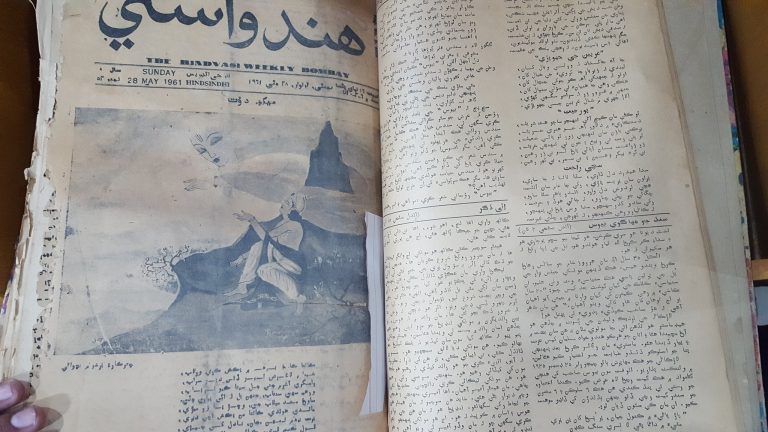
Hindvasi is one of the oldest newspapers of Sindhi language currently being published from Mumbai. During British Raj it faced many trials and tribulations and was even charged of sedition. This is the historical record of that sedition case.
Late Prof: Dr. Allah Rakhio Butt
Jethmal Pleads Innocence
Jethmal Parsram himself submitted a written statement before the court and empathetically rejected any kind of violence or racial hatred. He pleaded that he always tried to act as a loyal subject of the king Emperor. He had supported the war loan and other government measures of the same nature. He had also supported the British connection with India. He submitted several issues of the Hindvasi in support of his claim of loyalty and the preacher of non-violence.
Several witnesses were cross-examined in the month of June. They along with three Sindhi scholars included Swami Sherdhanaand, of Dehli, Mr. Desai, manager of Hanuman Mills, Delhi, the secretary of the Delhi Satyagraha Sabha, Mr. Nizamuddin, a Shia shopkeeper of Chandni Chowk, Delhi and Mr. Jamaluddin Kamaluddin, cloth merchant of Kooch-e-Rahman, Delhi.
The prosecution placed on the record 13 articles which appeared in the Hindvasi during the period from 11 February to 13 April 1919. Of them five were considered most harmful. The contents of the articles that dated February 11-13, March 8, 26 and 29 and April, 13 were fully analyzed. The February 11 article was headed “The period in the Rowlatt Act is bait to catch Indians with”. The article complained of government’s peculiar habit of breaking promises so much so that it had become hard to believe any of its fresh promises.
8 March article opened with a quotation from the Gita: “Get up and fight on the battlefield”. Many examples of Indian bravery and valour were cited. The crux of this article was reported by the Daily Gazette: “It is nothing that 33 crores of people are dying and passing their lives in the condition of the beasts… We are called revolutionaries and the bills are passed against us when we try to emerge from our conditions”.
26 March article advised what downtrodden India had to do in the darkest period she was passing through. It contained a candid advice: “The black bills have wound themselves round her throat. There are given various fanciful and malicious accounts of the reasons why Rowlatt legislation was passed”. These articles were considered by the prosecution as: “An attempt to subvert the local of the Indian army, the Mohammedan population and Indians general”.
Another article in the 26 March issue of the paper criticized the British who treated the Government of India as being “ghar ji” a house-hold affair of their own denning and kind of reform.
29 March article contained: “A call to prayer, a foreword of instructions for the day of humiliation fixed by Mr. Gandhi”. The writer asked: “Can we tolerate further such things as the passing of the Rowlatt legislation in the face of opposition of all non-official Indian members.”
The writer also compared law-making practice in England and India. He also talked about the story execution of Charles-I, the English monarch who was sent to gallows by the British people. The same article contained: “The exhortations that nations cannot be improved without sacrifice”.
The prosecution charged the accused: “To have been in a mental state bordering on the acutest depression…” And treated his writings on and before 5 April, 1919, as the culminating point of a long series and concluded that: “It is as if he were waiting impatiently for the opportunity when the unruly mobs at Delhi refused to disperse until they were fired upon”. Briefly this was the background of Jethmal’s April 5 article headed “Delhi Riots” which was considered gravel seditious and he was prosecuted. The prosecution picked up objectionable passages without considering the article as a whole. Particularly objectionable where references to: “Guns were fired because people laughed” “Indian (were) animals and beasts”, and the passage is like “Bravo Delhi bravo!” True the souls of the immortal brave ones are instilling the breadth of wondrous daring into the veins of the Indians on your holy soil so much so that they look with erect necks In the face of thousand guns”. “They never look hind; they walk straight forward”. This massacre for (bloodshed) of Delhi has instilled Hope in the whole of India”. 60 lakhs have died of influenza, what if a few thousands or a few lakhs laid down their lives in Satyagrah?”
The prosecution noted the phrase like: “sitting in the dirt of disgrace, “living in dread”, “ultimately dying of disease and sickness, the present life of restriction is hell in itself”, “what use is this living which is mere breathing?” All these phrases where considered by the prosecution “as the grossest pieces of seditious writing and meant to express idea, that the life under the government established by law in India is not worth living, and that almost anything, even suicide is better”.
On the grounds briefly discussed above the magistrate pronounced the accused guilty of two offences. Each of sedation and inciting hatred against the British in India and after detailed deliberations gave his verdict on 5 July 1919. The judgment comprised 32 typed pages of which he read out only the last three pages convicting the accused under section 124-A (sedition) and 153-A (inciting racial hatred). He was sentenced to rigorous imprisonment for two years under section 124-A, and two years under section 153-A. The second sentence had to take effect on the expiry of the first punishment. In this way the sentence cumulated to become four years. (Continues) __________________
Courtesy: Wise Sindh
Click here for Part-I, Part-II
Also read: Hindvasi Sedition Case Judgment